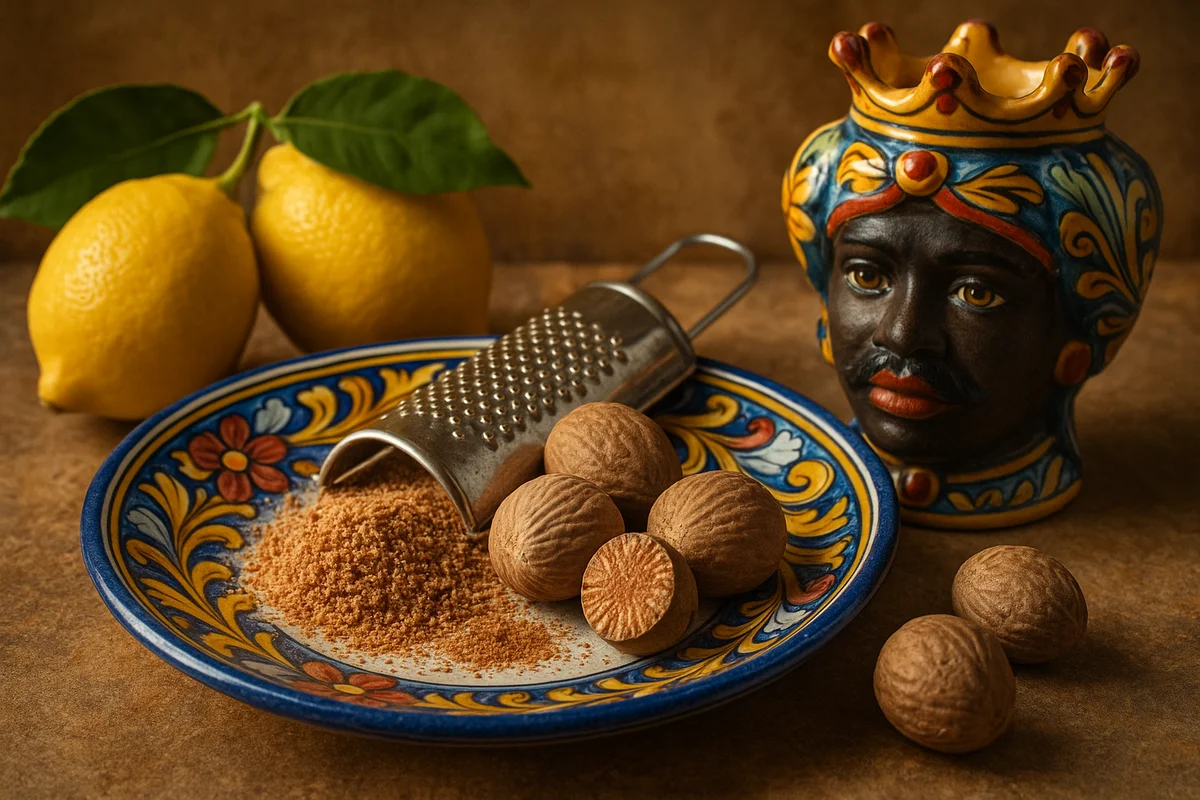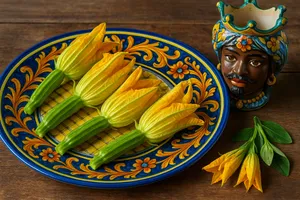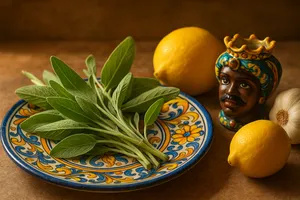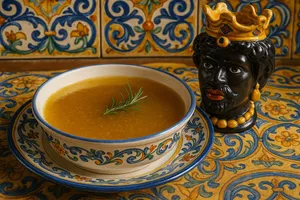Overview
Nutmeg is the dried seed of the fruit of the Myristica fragrans tree, a tropical plant native to the Moluccas in Indonesia. This prized spice, with its warm, sweet, and intense aroma, was for centuries one of the most sought-after and expensive spices in the world, at the centre of international trade routes and conflicts for its control. Today it is accessible and widely used in cooking for its unmistakable fragrance, which enhances both sweet and savoury dishes.
In Sicily, nutmeg was introduced through Arab and Venetian trade and became an integral part of the island’s culinary tradition. It is freshly grated to flavour meat and vegetable fillings, béchamel for baked pasta and timballi, mashed potatoes, spinach and other boiled vegetables, traditional biscuits and sweets, and warm beverages. Its enveloping aroma is especially appreciated in winter preparations and festive desserts. It must always be used in moderation: a small grating suffices, while excess can be overpowering and, in very large quantities, nutmeg can be toxic.
Characteristics
Nutmeg is an oval seed, 2–3 cm long, greyish brown, with a rough, ridged surface. It is very hard and compact, difficult to cut with an ordinary knife. The interior shows lighter marbled veins when sliced.
The aroma is intense, warm, sweet, and spicy, with woody, earthy, and slightly peppery notes. The flavour is aromatic, warm, lightly sweet, with a faint bitter-spicy edge. It recalls other warm spices such as cinnamon and cloves, yet remains unmistakably unique.
High-quality nutmeg is firm, heavy, evenly coloured, and very fragrant. When grated, it immediately releases its strong aroma. Old or low-quality nuts are weakly scented and less flavourful.
Nutmeg and mace
The Myristica fragrans tree yields two distinct spices:
Nutmeg: The dried inner seed, greyish brown, the most common spice. It has a fuller, more robust flavour.
Mace: The bright red-orange aril that surrounds the seed, dried and sold as blades or ground. It has a more delicate, refined flavour—slightly sweeter and lighter than nutmeg. It is more expensive and less common. In Sicily it is rarely used, while nutmeg is widespread.
Although they come from the same fruit, they have slightly different flavour profiles and partially distinct uses.
Origin and history
Nutmeg originates from the Moluccas (the Spice Islands) in Indonesia. For centuries, these islands were the only place where nutmeg trees grew, making the spice extremely rare and valuable.
During the Middle Ages, Arab and Venetian merchants controlled the spice trade to Europe, including nutmeg. During the Age of Exploration, the Portuguese, Dutch, and English fought for control of the producing islands. The Dutch East India Company maintained a monopoly for a long time, keeping prices extraordinarily high.
Only in the 19th century, when nutmeg plants were smuggled out and cultivated elsewhere (Zanzibar, Grenada), was the monopoly broken and the spice became more accessible. Today, the main producers are Indonesia, Grenada, India, and Sri Lanka.
Use in Sicilian cuisine
In Sicilian cooking, nutmeg has specific and traditional uses.
Meat fillings
Fillings for involtini, meatballs, braciole, and stuffed vegetables are seasoned with freshly grated nutmeg, which adds warmth and depth. It is a classic ingredient in meat fillings for cannelloni, lasagne, and timballi.
Béchamel
Sicilian béchamel, used in baked pasta, lasagne, and timballo di anelletti, is always flavoured with nutmeg. A light grating into the warm béchamel is essential to turn a simple sauce into a fragrant, enriched preparation.
Boiled vegetables
Spinach, chard, courgettes, cauliflower, and broccoli are often seasoned with butter or oil and a touch of nutmeg, which enhances their flavour.
Mashed potatoes
Sicilian mashed potatoes are aromatized with nutmeg, adding complexity to the delicate potato flavour.
Vegetable flans and savoury pies
Vegetable flans, savoury pies, and potato gateau are commonly seasoned with nutmeg, which helps bind and lift the flavours.
Desserts
Nutmeg appears in some traditional Sicilian sweets, especially those spiced for festive occasions: Christmas biscuits, mustazzoli, and certain types of cassatelle. It is used in small quantities along with cinnamon and cloves.
Warm beverages
A sprinkle of nutmeg enhances hot milk, hot chocolate, cappuccino, and flavoured coffee. It is particularly appreciated in winter for its warm, enveloping aroma.
How to use nutmeg
Nutmeg should always be grated fresh to preserve its aroma. A special nutmeg grater (small, with very fine holes) or the fine side of a common grater works well. Grate only the amount needed directly onto the dish.
The quantity must always be minimal: a few gratings are enough to season a dish for 4–6 people. A whole nutmeg lasts a long time, even months, when used sparingly.
Add nutmeg towards the end of cooking or directly to the finished dish, as prolonged high heat diminishes its aroma. In béchamel and sauces, it is added when the preparation is nearly finished.
Do not overuse it: too much nutmeg makes a dish bitter and unpleasant, and can cause discomfort. The rule is: less is more. You can always add more—but never remove excess.
Nutmeg: whole or ground?
Nutmeg is sold whole (the traditional and preferable form) or ground (more convenient but less aromatic).
Whole nutmeg: Keeps its aroma intact until grated. It stores well for years while remaining fragrant. It requires the right grater. It is the best choice for those who cook regularly and want maximum aroma.
Ground nutmeg: Convenient and ready to use, without a grater. Loses aroma quickly after opening, even when stored properly. Should be used within a few months. Suitable for occasional use or convenience.
Chefs and pastry cooks always prefer whole nutmeg grated at the moment for its superior aroma and control.
Storage
Whole nutmegs keep for several years in an airtight container in a cool, dry, dark place. Store them in a well-sealed glass or metal jar, away from heat and light.
Ground nutmeg keeps for 6–12 months but gradually loses aroma. Once opened, it should be used within 3–6 months. Store in a cool, dark place.
Nutmeg should not be refrigerated, as humidity can damage it. Room temperature in a dry environment is ideal.
Tips for buying
When buying whole nutmeg, choose firm, heavy nuts with uniform grey-brown colour and strong aroma. Avoid light, hollow nuts or those with deep cracks, signs of deterioration, or weak scent.
Prefer whole nutmeg over ground for better quality and longevity. If buying ground, check the packaging date—freshness is crucial. Buy from reliable suppliers.
Quality nutmeg is moderately priced but not cheap. Extremely low prices may indicate old or inferior product. A whole nutmeg is inexpensive and long-lasting, so quality is worth the investment.
Properties and precautions
Nutmeg contains essential oils with aromatic and traditionally medicinal properties. Folk medicine regarded it as digestive, carminative, and stimulating. It was used in small amounts to alleviate digestive discomfort, nausea, and bloating.
However, it is important to know that in high doses (over 5–10 grams—equivalent to 1–2 whole nuts) nutmeg is toxic. It contains myristicin, a psychoactive compound which in large quantities causes hallucinations, nausea, dizziness, palpitations, and may be dangerous. Poisoning cases are rare but documented.
For regular culinary use (a light grating for flavouring), there is no risk. Cooking quantities are far below toxicity thresholds. Problems occur only when nutmeg is intentionally consumed in massive amounts, which never happens in normal cooking.
Nutmeg should be kept away from children and used sensibly, like all powerful spices.
Pairings
Nutmeg pairs well with:
- Dairy: milk, cream, cheese, béchamel
- Vegetables: spinach, courgettes, cauliflower, potatoes, pumpkin
- Meat: veal, pork, poultry (in fillings)
- Spices: cinnamon, cloves, cardamom (in sweet preparations)
- Desserts: custards, puddings, spiced biscuits, cakes
- Beverages: hot milk, chocolate, coffee, eggnog
It does not pair well with fish, seafood, or very delicate dishes, where it would overpower subtle flavours.
Curiosities
In the Middle Ages, nutmeg was so precious that it was literally sold at the price of gold. Merchants could grow wealthy from a single shipment.
The profession of “nutmeg seller” existed, where vendors travelled with a grater and nutmegs offering to grate the spice directly into the food or drink of wealthy customers, charging handsomely for the service.
Nutmeg was considered a protective amulet. Some carried it in pockets or small pouches to ward off illness and misfortune. This belief was also present in parts of rural Sicily.
During the Victorian era in England, ladies of high society carried tiny silver nutmeg graters to grate nutmeg into beverages during dinners and social events, a mark of refinement and wealth.
In some areas of Sicily, nutmeg was part of folk remedies: grated into warm milk with honey as a supposed remedy for insomnia and nervousness; mixed with oil and applied topically for rheumatic pain. Modern medicine does not confirm these uses, but they illustrate the spice’s historical significance.
The nutmeg tree is dioecious, meaning there are male and female trees. Only the females produce fruit, so both sexes must be planted. A female tree begins to produce after 7–9 years and can continue for over 60 years.
The fresh nutmeg fruit, similar to an apricot, splits open when ripe, revealing the seed (nutmeg) wrapped in bright red mace. In producing countries, even the fruit pulp is used for jams and preserves, while in the West only the dried spices reach the market.











